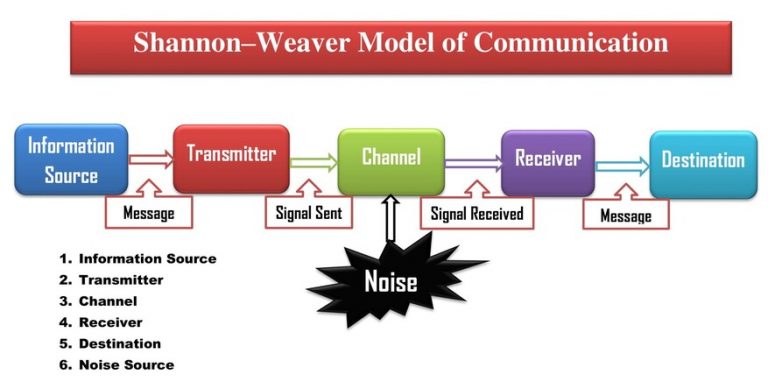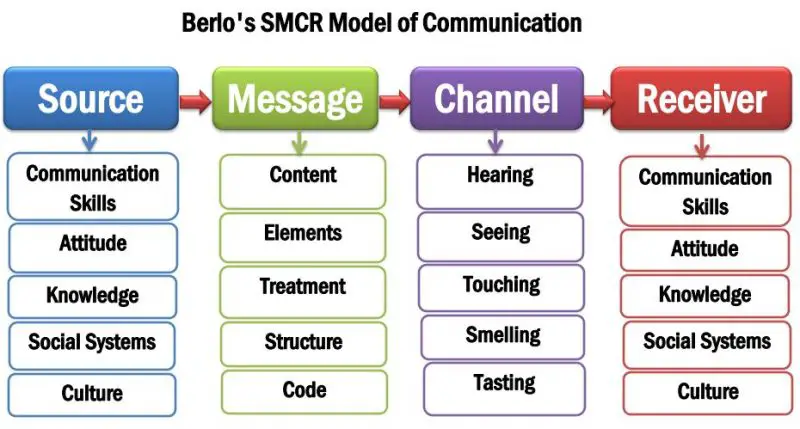Shannon and Weaver Model of Communication Explanation & Example. Also, Claude Shannon and Warren Weaver’s Model. Shannon and Weaver Model of Communication Example Situation.
Shannon and Weaver’s Model of Communication
American mathematician Claude Elwood Shannon and scientist Warren Weaver introduced a linear communication model in 1949 in the article THE MATHEMATICAL THEORY OF COMMUNICATION. Therefore, it is called Shannon and Weaver’s communication model. Initially, they proposed this mathematical model to describe the signal-transmitting system and enhance telephone communication by minimizing noise. Now it is applied in every field of information and communication broadly. However, they did not present the “Feedback”; thus, the Shannon and Weaver model is an example of a linear communication model. Initially, the Shannon-Weaver model excluded feedback; hence, it is a linear communication model. Therefore, it was an incomplete communication model for not including Feedback and different types of nonverbal communication cues.
Later, Norbert Weiner included feedback on the model in countering the criticism of the one-way communication approach. Shannon and Weaver’s communication model is called the “Mother of all Communication Models” for its extreme popularity. It is also called the mathematical theory of communication, Shannon theory, and information theory in the engineering disciplines.
Shannon Weaver Model Linear or Transactional
Shannon and Weaver introduced the linear communication model with six elements: information source, transmitter, channel, receiver, destination, and noise source. The authors did not add feedback to this model in 1949; therefore, it is a linear communication model. However, later the feedback was included by Norbert Wiener in 1950.
Feedback in Shannon Weaver Model
In 1950, Norbert Wiener added the “Feedback” in Shannon and Model. He presented the feedback system in the book (The Human Use of Human Beings) initially published in 1950. Norbert Wiener is also the founder of cybernetics theory, which explains the feedback system. Shannon and Weaver have not published the modified model, including feedback. Hence, the original model of Shannon and Weaver is linear, as they did not mention feedback.
Shannon-Weaver Communication Model Examples of Situation
Shannon and Weaver Model Example: 1
For example, Jon calls his friend (Jony) to meet on Monday through the smartphone. Children are screaming around Jony; therefore, he cannot hear what Jon says.
Jon is a source of information that generates the message. The information source is Jon, also the sender of the message. Additionally, the smartphone is a channel that converts the message(voice) into a sound wave signal to transmit from the sender(Jon) to the receiver(Jony). Children screaming sound is the noise that bars the communication process. Jony decodes the voice into a message, so he is the receiver and destination of the message.
Shannon and Weaver Model Example: 2
The lecturer conducts online classes through the Zoom virtual meeting platform. However, a student cannot hear the lecture properly due to the raining sound, also known as the physical noise in communication.
The lecturer is the source of information. Zoom meeting is the channel of communication that transmits message into a signal to convey to students. The students receive messages via their smartphones or computers. So, they are the receiver of the message. Finally, the rain sound is the noise that distracts the student from hearing the lecture correctly.
Shannon – Weaver Model Example: 3
Jon is listening to the morning news via the radio. The news presenter broadcasts news regarding today’s weather forecast. However, he cannot hear the report of the radio frequency interference (RFI). RFI is created from an internal wireless system.
The news presenter is the information source, the radio is the channel, Jon is the receiver, and radio frequency interference is also known as electrical noise.
These are the 3 example situation of the Shannon-Weaver model.
Shannon and Weaver Model of Communication Explanation
The Shannon and Weaver communication model includes six elements: Information Source, Transmitter, Channel, Receiver, Destination, and Noise Source. However, Shannon and Weaver did not mention “Feedback” in 1949; hence, it is a linear communication model like the Lasswell communication model. Many researchers and practitioners criticize this model for not adding “Feedback.” Therefore, later, Norbert Weiner included “Feedback” to describe the transactional communication process.
Many communication models have been postulated based on this model- for example Osgood-Schramm transactional model.
Shannon and Weaver Model of Communication Elements
The Six Elements of Shannon and Weaver’s Model of Communication are:
- Information Source.
- Transmitter.
- Channel.
- Receiver.
- Destination.
- Noise Source.

1. Information Source
Information source refers to the sender of the communication process that conveys the message to the receiver. It also indicates the person who generates the information and initiates the communication process.
For example, the lecturer gives a motivational speech to new students in the orientation program using a dynamic microphone. In the meantime, an airplane passes over the program. So students can not hear the lecturer’s speech for a while.
2. Transmitter
The transmitter refers to the message converter that changes the message into a signal to transfer through the communication channel. It is also called the encoding process. The messages are spoken words, written messages, pictures, music, and nonverbal cues.
For example, the lecturer’s speech transmits through the dynamic microphone. The microphone converts the spoken word into a signal to transfer via an electrical current on the wire.
3. Channel
Channel is the medium that conveys the message from senders to receivers. Communicators utilize distinguished channels based on communication, such as human senses, radio, television, newspaper, electronic tools, social media, and so on.
For example, the wire is the channel that conveys messages from the lecturer to students.
4. Receiver
Receivers are the people who convert the signal into a meaningful message. They are responsible for decoding the message. So, the receiver is the decoder of the communication process.
For example, students are the receivers who process the signal and sound into a meaningful message.
5. Destination
Destination indicates both senders and receivers of the communication process who encode and decode the message.
According to Shannon and Weaver’s Model, “when I talk to you, my brain is the information source, yours the destination; my vocal system is the transmitter, and your ear and the associated eighth nerve is the receiver.”
6. Noise
Noise is the unwanted sound of the communication process that disrupts effective communication. Communicators found noises in every type of communication process, including verbal, nonverbal, written, visual, face-to-face, mediated, and group communication. The most common types of noise in communication are physical, physiological, psychological, semantic, electrical, syntactical, cultural noise, and so more.
For example, airplane sound is considered the physical noise in communication that distracts the students from hearing the speech.
Shannon and Weaver Communication Model Advantages and Disadvantages
Importance of Shannon and Weaver Communication Theory
Firstly, Shannon and Weaver’s theory enhances telephone communication by representing six essential elements.
It articulates the signal-transmitting system through the medium.
For the first time, this theory explains the communication noises that barrier effective message transmission. Noise is a significant communication component.
Finally, Shannon-Weaver’s framework is the first communication model that explains message sending process through an instrument.
Shannon and Weaver Communication Model Disadvantages
Firstly, It is a linear communication model due to not demonstrating Feedback.
Additionally, this model is unsuitable for explaining the transactional communication process. For example, face-to-face communication is an example of transactional interaction.
Shannon Weaver’s model was designed to explain mediated communication.
Conclusion
In short, the Six Elements of the Shannon and Weaver Model o are Information Source, Transmitter, Channel, Receiver, Destination, and Noise Source. Eventually, Norbert Weiner included the seventh element(Feedback) to make it a transactional communication model. Shannon and Weaver’s Model was introduced in 1949 and is undoubtedly a linear communication model like Aristotle, Lasswell, and David Berlo’s SMCR Model.
Established Year of the Shannon-Weaver Model?
The Shannon and Weaver model was introduced in 1949. However, there is controversy regarding the establishment year of the Shannon and Weaver model. Claude Shannon published the article(A Mathematical Theory of Communication) in Bell System Technical Journal in 1948 known as the Shannon theory. Warren Weaver republished the previous article in 1949, adding more information and discussing the model’s implication for the effective communication process. They also renamed The Mathematical Theory of Communication while republishing it in a book. Therefore, it is known as the Shannon-Weaver model of communication.
Warren Weaver did not contribute to the article (A Mathematical Theory of Communication) published in 1948 by Claude Elwood Shannon. So, Weaver’s name cannot be included in the model published in 1948. He co-authored the same article in 1949 and renamed it “The Mathematical Theory of Communication” while reprinting it in the book. The Mathematical Theory of Communication is called Claude Shannon and Warren Weaver model of communication. So, it is rational to say that the Shannon and Weaver model was introduced in 1949, not 1948.
Shannon-Weaver’s Communication Theory Pdf Download-
A Mathematical Theory of Communication
Shannon, 1948 Reference
| Shannon, C. E. (1948). A mathematical theory of communication. The Bell system technical journal, 27(3), 379-423. |
Shannon and Weaver, 1949 Reference
| Shannon, C. E., & Weaver, W. (1949). The mathematical theory of communication. The University of Illinois Press |
Citation For This Article
| APA- 7th Edition: Kobiruzzaman, M. M. (2023). Shannon and Weaver Model of Communication Explanation & Examples. Newsmoor- Best Online Learning Platform. https://newsmoor.com/shannon-and-weaver-model-of-communication-explanation-examples/ |
